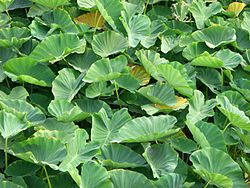Typical yield
17.5 t/ha
Varieties
2
Pest/Disease
5
Seasons
2
Profile
- Growth habit
- perennial
- Lifecycle (days)
- 180–300
- Primary uses
- Tuber/root; leaves as vegetable
- Pollination
- insect
- Origin / distribution
- Wet tropics/subtropics; humid lowlands & mid-altitudes
Environment
Climate
Temp optimal
21–28 °C
Rain optimal
1500–2500 mm/yr
Altitude
0–2000 m
Soil
pH optimal
5.8–6.5
Soil type
Deep fertile loam; moist/wet; avoid stagnation
Farmer Guide
Row spacing
100 cm
Plant spacing
75 cm
Depth
8 cm
Seed rate
1000 kg/ha
Nursery days
Planting: Use healthy corm setts/cormels. Raised beds or ridges. Keep soil moist and weed early; mulch.
Transplanting: Vegetative planting; handle setts gently to avoid rot.
Irrigation: Keep evenly moist; frequent light irrigation in dry spells.
Fertigation: Split N into small doses during vegetative growth under irrigation.
Pest scouting: Monitor for taro leaf blight and corm rots; remove infected leaves.
Pruning/Training: Remove old/diseased leaves; keep beds clean.
Harvest: Harvest at full corm size (6–10 months) when lower leaves senesce.
Postharvest: Cure in shade; handle gently; store cool/ventilated.
Nutrient Schedule
| # | Stage | DAP | Product | Rate | Targets (kg/ha) | Notes |
|---|---|---|---|---|---|---|
| 1 | Basal | 0 | NPK 12-24-12 | 150 kg/ha | N: —, P₂O₅: —, K₂O: — | Band/broadcast and lightly incorporate |
| 2 | Topdress | 60 | CAN 26% N | 120 kg/ha | N: —, P₂O₅: —, K₂O: — | Apply on moist soil |
| 3 | Micronutrients | 70 | Trace mix (Zn, B) | 0 — | N: —, P₂O₅: —, K₂O: — | Foliar per label |
Nutrient Requirements
| Nutrient | Stage | Amount | Unit |
|---|---|---|---|
| N | Basal | 40 | kg/ha |
| P₂O₅ | Basal | 30 | kg/ha |
| K₂O | Basal | 60 | kg/ha |
| N | Topdress | 40 | kg/ha |
Images

| Name | Country | Maturity | Traits |
|---|---|---|---|
| Local Cocoyam | KE | 240 | Large corms; good leaf production |
| Dasheen type | UG | 220 | Leaves and corms edible; wetland tolerant |
| Stage | Product | Rate (kg/ha) | Notes |
|---|---|---|---|
| Basal | NPK 12-24-12 | 150 | |
| Topdress | CAN 26% N | 120 | ~60 DAP on moist soil |
| Name | Type | Symptoms | Management |
|---|---|---|---|
| Taro leaf blight | disease | Leaf lesions | Sanitation; protectants |
| Taro leaf blight (Phytophthora colocasiae) | disease | Rapid foliar blight | Sanitation; spacing; resistant lines; protectants |
| Corm/cormel rots (Pythium/Fusarium) | disease | Soft rot; plant collapse | Healthy seed; drainage; rotation; avoid injury |
| Aphids | pest | Leaf curling; sooty mold | Conserve natural enemies; soft insecticides if needed |
| Cutworms | pest | Cut seedlings at base | Baits; sanitation; timely replanting |
| System | Typical | Min | Max | Notes |
|---|---|---|---|---|
| rainfed | 15 | 8 | 25 | Fresh corms |
| irrigated/wetland | 20 | 12 | 35 | Well-managed fields |
| Country | Region | Planting | Harvest |
|---|---|---|---|
| KE | Humid zones (long rains) | Mar–Apr | Sep–Dec |
| KE | Humid zones (short rains) | Oct–Nov | May–Aug |
| Country | Region | Suitability |
|---|---|---|
| KE | Arid/semi-arid uplands | Low |
| KE | Humid lowlands & mid-altitudes | High |
| KE | Humid zones | High |
| TZ | Coastal & wet valley bottoms | High |
| UG | Lake Victoria basin | High |
